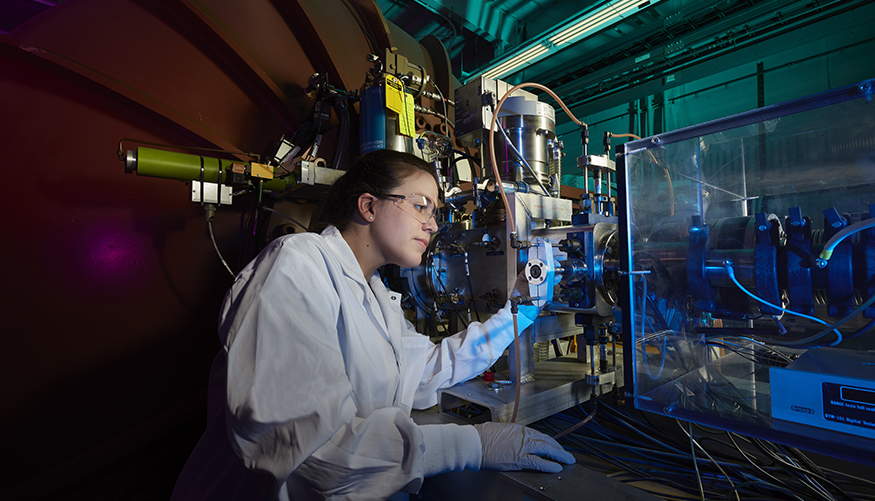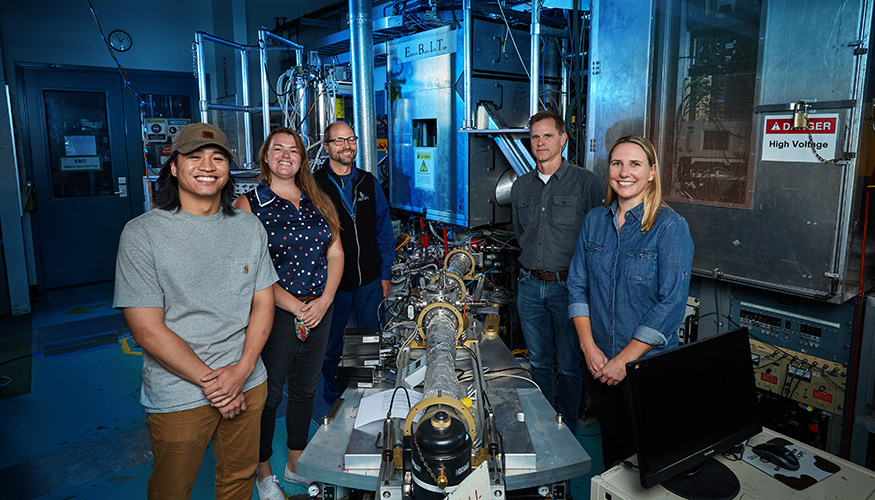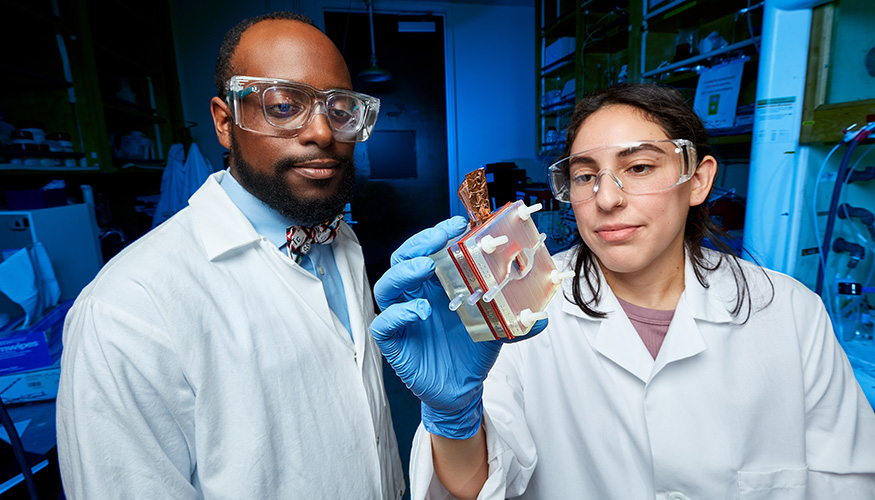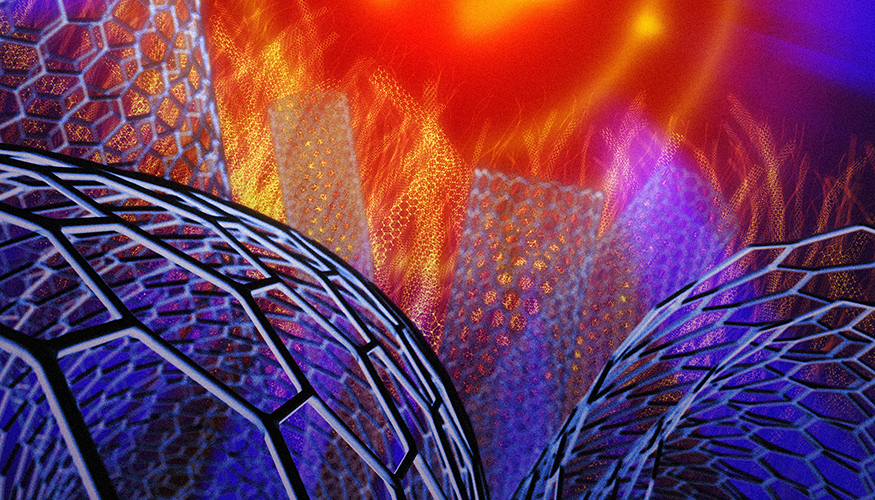- Home
- Collaborate
Collaborate
Researchers from LLNL’s Physical and Life Sciences Directorate (PLS) partner with universities, companies, and various state and federal government agencies to accelerate innovation and solve increasingly complex scientific and national security challenges.
These collaborations bring diverse perspectives, capabilities, and creativity to our mission-critical research, while fostering opportunities to engage tomorrow’s innovators. Partnerships also maximize the impact of discoveries made at LLNL as we explore options to commercialize these discoveries to benefit the U.S. economy and our national security.
- Use our world-class research facilities
- Conduct joint research
- Provide career exploration and learning opportunities for students
- Foster technology maturation and commercialization

Use our world-class research facilities
Many of LLNL’s experimental and computational resources are open to our collaborators, including partners on joint research projects, as well as our student interns. By fostering access to these resources, we provide a venue for early-career scientists to gain hands-on experience using sophisticated tools, while also sparking ideas regarding future enhancements to these resources.
Examples of user facilities at LLNL that are regularly used by PLS scientists include the:
- Jupiter Laser Facility (JLF), which is part of the Department of Energy’s LaserNetUS consortium and fosters researcher access to U.S.-based high-intensity laser platforms. JLF also provides an ideal training environment for students and early-career investigators, enabling direct user operation of experiments and diagnostic tools, as well as opportunities to test and develop novel experimental techniques.
- Center for Accelerator Mass Spectrometry, which enables scientists to conduct ultra-sensitive isotope ratio measurements and ion beam analytical techniques that address a broad spectrum of challenges, including analyzing isotopic signatures of interdicted material, studying isotopes to accelerate development of therapeutics, and measuring cosmogenic nuclides in rocks and sediment to understand climate change.
- National User Resource for Biological Accelerator Mass Spectrometry (AMS) at LLNL, which provides ultra-high sensitivity, quantitative isotopic analysis for biomedical researchers, including a dedicated biological AMS spectrometer in a room configured with biosafety level 2 controls.
In addition to facilities that offer formal user programs for external researchers, other LLNL scientific resources are often available to collaborating researchers from academic institutions and industry partners who are working on joint research projects with LLNL scientists. Postdocs and visiting faculty at LLNL—including faculty who are part of LLNL’s mini-faculty sabbatical program—are able to access these resources as part of their research at LLNL.
To learn more about opportunities to access LLNL resources, visit LLNL’s Facilities, Centers and Institues webpage.

Conduct joint research
Many PLS research projects involve collaborators from other national labs, industry, and academia. These types of collaborations benefit our staff, as well as our collaborators. For example, researchers benefit from access to experimental resources not available at their home institution. In addition, they can participate in LLNL’s mini-faculty sabbatical program, where they visit LLNL for up to three months to exchange knowledge and build partnerships.
Examples of multi-institutional research collaborations where PLS staff serve as project leads or co-leads include:
- Experts from LLNL’s Space Science Institute collaborate with the NASA Goddard Space Flight Center on instrument development and calibration for next-generation astrophysical x-ray missions. We also engage with collaborators to develop, deploy, and adapt multilayer coating technologies for observatories and space-based telescopes—work that involves colleagues from NASA and the National Oceanic and Atmospheric Administration.
- Scientists from LLNL’s Laboratory for Energy Applications for the Future (LEAF) lead predictive modeling and simulation activities for multi-institutional research consortia sponsored by the Department of Energy (DOE), including DOE’s HydroGEN and HyMARC consortia that are exploring innovative solutions for hydrogen production, storage, and delivery.
- Climate science experts at LLNL play key roles in inter-agency research aimed at increasing access to climate models and research data. For example, LLNL is the lead institution in DOE’s Energy Exascale Earth System Model (E3SM) Project, which links earth system and energy models to assess how energy use impacts our ecosystems.
- LLNL bioscientists lead a multi-institutional research project aimed at developing new types of vaccines and new vaccine delivery options. Funded by the National Institutes of Health, this Cooperative Research Center includes University of California collaborators, as well as opportunities for investigators from other institutions to participate in pilot projects related to the center’s research objectives.
- LLNL scientists lead the nEXO project, a DOE-funded initiative aimed at studying neutrinos—tiny, nearly massless particles with no charge. The nEXO collaboration involves experts from 36 institutions, including five national labs and more than a dozen U.S. universities, who are searching for a rare type of nuclear decay called neutrinoless double beta decay.

Provide career exploration and learning opportunities for students
We collaborate with academic institutions to help them achieve their educational goals for their undergraduate and graduate students. For example, we collaborate with colleges and universities to raise awareness of emerging career pathways that their students might want to explore. In addition, we partner with institutions to enhance curricula, or to develop a workshop, seminar, or summer institute in a specific science area.
The cornerstone of these student-focused collaborations is our internship programs. PLS hosts student interns over the summer or during the academic year, providing hands-on research experience and mentoring by a PLS scientist. We partner with our colleagues at academic institutions to promote internship opportunities at LLNL and other national laboratories.
Many of our collaborations involve student outreach, where we help raise awareness of careers with a science and technology focus. For example, PLS scientists can participate in a university’s career event, answering questions informally or serving as a guest speaker. Our internship mentors can join with their student intern to discuss what it’s like to serve as an intern at LLNL.
Several of LLNL’s research centers are the focal point for our academic outreach in specific disciplines, including:
- The Glenn T. Seaborg Institute at LLNL builds educational and research partnerships in transactinium science, including nuclear forensics and environmental radiochemistry. For example, the Institute hosts summer interns who want to gain hands-on research experience. The Seaborg Institute also hosts postdoctoral researchers and collaborates with faculty to expand student outreach.
- The High Energy Density Science (HEDS) Center at LLNL facilitates opportunities for collaborative explorations of matter and energy under extreme conditions. Together with partners, the Center works to increase awareness of careers in HEDS research. The Center also offers informal learning experiences and collaborates with universities to develop curriculum in emerging areas of HED science.
- LLNL’s Energetic Materials Center is home to many of our nation’s leading experts in high explosives, who engage in joint research projects with colleagues at academic institutions that have relevant research programs. These joint projects often include opportunities for students to participate in an LLNL-hosted internship and explore a possible future research career in energetic materials.
We are also involved in externally funded initiatives aimed at engaging students from minority-serving institutions. Examples of these types of initiatives include:
- LLNL’s participation in the Workforce Development Program for Teachers and Scientists, offered by the Department of Energy (DOE), which enables us to collaborate with U.S.-based minority-serving institutions in outreach and internship programs. As part of this DOE program, the Glenn T. Seaborg Institute at LLNL leads an initiative that involves more than a dozen university partners and 8 research centers at LLNL. Together, they develop student outreach strategies aimed at raising awareness of career opportunities in STEM fields, as well as opportunities to participate in internships at LLNL that are funded through the DOE workforce development program.
- Research consortia formed to address challenges in high-energy-density (HED) science research, such as the Consortium for HED Science, a partnership that includes LLNL’s HED Science Center and three U.S.-based minority-serving institutions. The participating institutions are developing enhanced HED science curriculum and fostering undergraduate student interest in HED science.
To learn more about LLNL’s academic engagement programs, reach out to us by email at aeo-info [at] llnl.gov (aeo-info[at]llnl[dot]gov).

Foster technology maturation and commercialization
LLNL partners with industry through sponsored research and development projects that solve technical challenges and accelerate scientific advancements. For example, we collaborate with industry partners to adapt technology created by LLNL innovators so it can more effectively address national security and energy security needs. We also partner with U.S. companies to commercialize technology developed at LLNL, growing our nation's economy through commercialization of scientific discoveries.
Examples of efforts led by PLS scientists include:
- Technology that enables early detection of pathogens, initially developed at LLNL for biodefense applications and adapted by our industry partner for use as a genetic screening tool and for personalized cancer treatment.
- New types of radiation detection materials, including radiation-detecting scintillators that light up when triggered by specific types of radioactive emissions. These materials offer the flexibility that manufacturers need to produce new radiation detection technology that protects our nation.
- Polyelectrolyte Enabled Liftoff (PEEL) technology, which makes it possible to fabricate ultra-thin, free-standing polymer films that are capable of bearing loads ranging from milligrams to grams. It was developed for laser experiments, but can also be used for catalysis, filtration, and wound-healing applications.
- Advanced carbon aerogels that can be used in applications such as energy production and storage, electrocatalysis, and desalination. The aerogels offer electrical conductivity, chemical stability, and environmental compatibility, and they can be used to produce lightweight, 3D-printed materials with unique architectures.
For more information about ways that LLNL collaborates with industry to advance the development and commercialization of scientific discoveries, contact LLNL’s Innovation and Partnerships Office.




